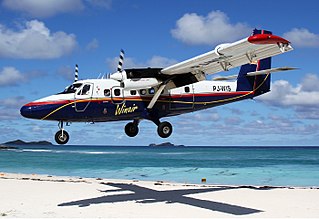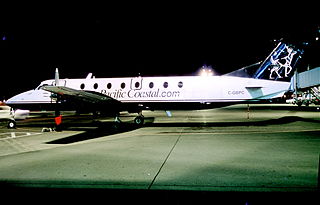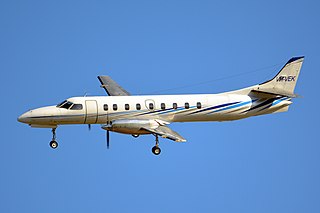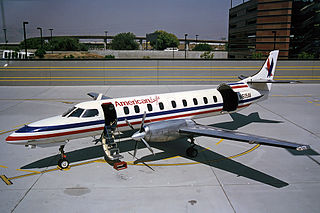
Air North Charter and Training Ltd., operating as Air North, Yukon's Airline, is a Canadian airline based in Whitehorse, Yukon. It operates scheduled passenger and cargo flights throughout Yukon, as well as between Yukon and the Northwest Territories, British Columbia, Alberta, and Ontario. The airline also operates charter flights throughout Canada and Alaska. The airline also provides ground handling services and fuel services to other airlines throughout Yukon, and it also provides ground handling services at Vancouver International Airport and Edmonton International Airport. Its main base is Erik Nielsen Whitehorse International Airport.

The de Havilland Canada DHC-6 Twin Otter is a Canadian STOL utility aircraft developed by de Havilland Canada in the mid-1960s and still in production today. De Havilland Canada produced it from 1965 to 1988; Viking Air purchased the type certificate, then restarted production in 2008 before re-adopting the DHC name in 2022. In 2023 DHC restarted production of the 300 series, in addition to the Series 400 produced by Viking. The aircraft's fixed tricycle undercarriage, STOL capabilities, twin turboprop engines and high rate of climb have made it a successful commuter airliner, typically seating 18–20 passengers, as well as a cargo and medical evacuation aircraft. In addition, the Twin Otter has been popular with commercial skydiving operations, and is used by the United States Army Parachute Team and the 98th Flying Training Squadron of the United States Air Force.

The de Havilland Canada DHC-3 Otter is a single-engined, high-wing, propeller-driven, short take-off and landing (STOL) aircraft developed by de Havilland Canada. It was conceived to be capable of performing the same roles as the earlier and highly successful Beaver, including as a bush plane, but is overall a larger aircraft.
Empire Airlines is a cargo and former passenger airline based in Hayden, Idaho, near Coeur d'Alene. It operates over 120 scheduled cargo flights a day in 18 US states and Canada. Empire also operated passenger service within Hawaii, under the name "Ohana by Hawaiian", between 2014-2021 in partnership with Hawaiian Airlines. Its main base is Coeur d'Alene Airport with a hub at Spokane International Airport. The company slogan is We Can Do That.

Pacific Coastal Airlines is a Canadian regional airline that operates scheduled, charter and cargo services to destinations in British Columbia. Its head office is located in the South Terminal of Vancouver International Airport in Richmond, British Columbia. Its main base is Vancouver International Airport.
Lethbridge Airport, previously Lethbridge County Airport, is located 4 nautical miles south-southeast of Lethbridge, Alberta, Canada. It is 10–15 driving minutes from downtown Lethbridge, and has scheduled service to the city of Calgary, Alberta. The airport is classified as an airport of entry by Nav Canada and is staffed by the Canada Border Services Agency (CBSA) on a call-out basis from the Sweetgrass-Coutts Border Crossing. CBSA officers at this airport can handle general aviation aircraft only, with no more than 15 passengers. The airport hosts the biennial Lethbridge International Airshow.

The Beechcraft 1900 is a twin-engine turboprop regional airliner manufactured by Beechcraft. It is also used as a freight aircraft and corporate transport, and by several governmental and military organizations. With customers favoring larger regional jets, then-owner Raytheon ended production in October 2002.

The Fairchild Swearingen Metroliner is a 19-seat, pressurized, twin-turboprop airliner first produced by Swearingen Aircraft and later by Fairchild Aircraft at a plant in San Antonio, Texas.

Trans-Canada Air Lines Flight 810-9 was a Canadair North Star on a scheduled flight from Vancouver to Calgary. The plane crashed into Mount Slesse near Chilliwack, British Columbia, Canada, on 9 December 1956 after encountering severe icing and turbulence over the mountains. All 62 people on board died, making it one of the deadliest airline crashes ever as of that date; it still ranks as the sixth deadliest air disaster in Canadian history.

The Swearingen Merlin or the Fairchild Aerospace Merlin is a pressurized, twin turboprop business aircraft first produced by Swearingen Aircraft, and later by Fairchild at a plant in San Antonio, Texas.

Santa Bárbara Airlines Flight 518 was an ATR 42–300 twin-turboprop aircraft, registration YV1449, operating as a scheduled domestic flight from Mérida, Venezuela, to Caracas that crashed into the side of a mountain on 21 February 2008, shortly after take-off. There were 43 passengers on board, with a crew consisting of two pilots and a flight attendant. The wreckage was discovered a day later with no survivors. It was the deadliest aviation accident involving an ATR 42 until Trigana Air Flight 267 crashed in Papua, Indonesia, in 2015 with 54 deaths.

Seair Seaplanes is a scheduled and charter airline based in Richmond, British Columbia, Canada. The airline flies routes between the Vancouver International Water Airport and the Nanaimo Harbour Water Airport, as well as other Gulf Islands in the Strait of Georgia, exclusively with float planes.

On 14 October 2011, a Cessna 208 Caravan turboprop passenger aircraft operated by Moremi Air on a domestic flight from Xakanaka camp to Maun, Botswana, crashed and caught fire shortly after take-off, killing eight of the twelve people on board.

AVAir Flight 3378, was a scheduled flight under the American Eagle branding from Raleigh–Durham International Airport to Richmond International Airport which crashed after takeoff from Raleigh-Durham International Airport late on the night of February 19, 1988. All 12 people on board were killed in the accident.
Delta Connection is a brand name for Delta Air Lines, under which a number of individually owned regional airlines primarily operate short- and medium-haul routes. Mainline major air carriers often use regional airlines to operate services via code sharing agreements in order to increase frequencies in addition to serving routes that would not sustain larger aircraft as well as for other competitive or operational reasons.

On 31 July 2010, a Convair CV-580 Airtanker aircraft operated by Conair Aviation crashed while on a firefighting mission near Lytton, British Columbia, Canada. Both crew members, the only people on board, were killed.

Trans-Colorado Airlines Flight 2286 was a scheduled domestic passenger flight from Denver, Colorado, to Durango, Colorado, operated for Continental Express by Trans-Colorado Airlines. On January 19, 1988, Flight 2286 crashed onto terrain near Bayfield, Colorado, while on approach to Durango-La Plata County Airport. Out of the seventeen people on board, nine were killed, including both crew members.

Air Fiji Flight 121 (PC121/FAJ121) was a scheduled domestic passenger flight from Nausori International Airport in Fiji's capital Suva to Nadi International Airport in Nadi, operated by an Embraer EMB 110 Bandeirante. On 24 July 1999, the Bandeirante crashed into a mountain near Delailasakau, killing all 15 passengers and 2 crew on board, making it the deadliest aviation accident to occur in Fiji.

On the evening of April 1, 1993, a Swearingen Merlin III twin turboprop, carrying NASCAR champion Alan Kulwicki, crashed near Blountville, Tennessee, while on approach to the nearby Tri-Cities Regional Airport. All four people on board, including Alan Kulwicki, two executives of the Hooters restaurant chain, and the pilot, were killed.

On 12 May 2021, Key Lime Air Flight 970, a Fairchild Swearingen Metroliner operating a chartered cargo flight from Salida to Centennial, Colorado collided in mid-air with a private Cirrus SR22. Despite having sustained severe damage, the Swearingen Metroliner managed to land safely while the Cirrus SR22 deployed its CAPS system and safely parachuted to the ground. All three occupants on board both aircraft survived uninjured.

















